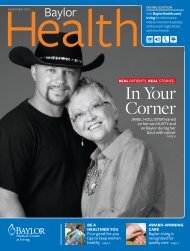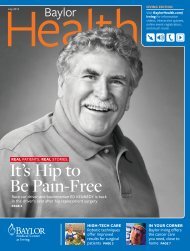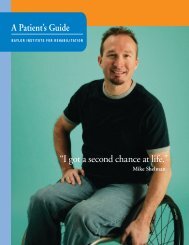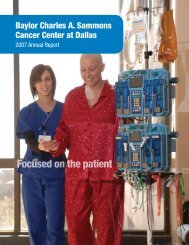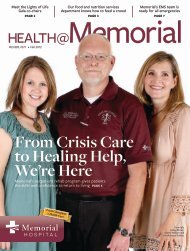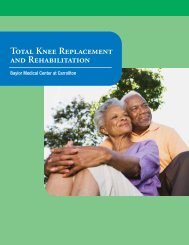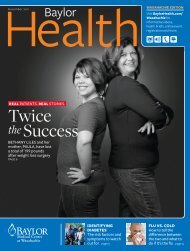McKinney - Baylor Online Newsroom - Baylor Health Care System
McKinney - Baylor Online Newsroom - Baylor Health Care System
McKinney - Baylor Online Newsroom - Baylor Health Care System
- No tags were found...
You also want an ePaper? Increase the reach of your titles
YUMPU automatically turns print PDFs into web optimized ePapers that Google loves.
Got Fiber?The benefits of a fiber-richdiet are virtually undisputed,from preventing constipationto reducing your risk for coloncancer. Though the standardAmerican diet includesapproximately 20 grams of fiberper day, experts recommend30 grams or more—and thatrequires some dietary finesse.Follow these four tips to get morefiber into your diet.1. Eat your veggies. And fruits,beans and whole grains, too. Theycontain more fiber—and fewercalories—than processed foods,meats and dairy products.2. Give cereal another go.It’s not your mom’s fiber cerealanymore; delicious variations onhigh-fiber cereals abound.3. Supplement. Though notrecommended as your primarysource of fiber, supplements cangive you a few extra grams to getyou where you need to be.4. Drink up. Fiber works byadding bulk to the inside of theintestines to draw in water andhelp things move along. Withoutenough water, it can causeconstipation.No MoreExcusesHERE ARE THE REAL REASONS you’renot getting your screenings—and howto get past them.EXCUSE: I DON’T HAVE TIME.A lot of these tests are just 20 to 30minutes. To save time, schedule all yourscreenings for one day and take the dayo ffw o r k .EXCUSE: I JUST FORGET.Make all your screening appointmentsfor your birthday month each year.EXCUSE: THEY’RE TOOEXPENSIVE.Even if you don’t have insurance, thereare plenty of low-cost and no-costoptions. Government programs offerdiscounts, and hospitals offer freescreenings at community health fairs.Talk to your doctor about your options.Save the Date!Commit to making an appointment—and keeping it—today. Your physiciancan tell you what screenings arerecommended for you. To find adoctor, visit FindDrRight.com/<strong>McKinney</strong> or call 1.800.4BAYLOR.EXCUSE: IT’S GOING TO HURT.True, some screenings are uncomfortable,but most aren’t painful at all. Your doctorcan tell you what to expect to ease yourconcerns. The peace of mind is well wortha bit of discomfort.EXCUSE: I DON’T WANTTO KNOW.Some people avoid screenings becausethey feel healthy, but these tests aredesigned to find disease before you havesymptoms—and when you may havemore options for treatment.<strong>Baylor</strong> Medical Center at <strong>McKinney</strong>, 5252 W. University Drive, <strong>McKinney</strong>, TX 75071. President: Scott Peek; Marketing/Public Relations Director: Kelly Maier; Editor: Jennifer Irwin. <strong>Baylor</strong> <strong>McKinney</strong> Main Number:469.764.1000; Parent Education Classes: 1.800.4BAYLOR (1.800.422.9567); <strong>Baylor</strong> <strong>McKinney</strong> Breast Center: 469.764.7000; <strong>Baylor</strong> <strong>McKinney</strong> Physician Referral: 1.800.4BAYLOR. Visit <strong>Baylor</strong><strong>Health</strong>.com/<strong>McKinney</strong> orcall 1.800.4BAYLOR for information about <strong>Baylor</strong> <strong>McKinney</strong>’s services, upcoming events, career opportunities and more.<strong>Baylor</strong> <strong>Health</strong> <strong>Care</strong> <strong>System</strong> Mission: Founded as a Christian ministry of healing, <strong>Baylor</strong> <strong>Health</strong> <strong>Care</strong> <strong>System</strong> exists to serve all people through exemplary health care, education, research and community service.The material in <strong>Baylor</strong><strong>Health</strong> is not intended for diagnosing or prescribing. Consult your physician before under taking any form of medical treatment or adopting any exercise program or dietary guidelines.Physicians are members of the medical staff at one of <strong>Baylor</strong> <strong>Health</strong> <strong>Care</strong> <strong>System</strong>’s subsidiary, community or affiliated medical centers and are neither employees nor agents of those medicalcenters, <strong>Baylor</strong> Medical Center at <strong>McKinney</strong> or <strong>Baylor</strong> <strong>Health</strong> <strong>Care</strong> <strong>System</strong>. Photographs may include models or actors and may not represent actual patients. <strong>Baylor</strong><strong>Health</strong> is published byMcMurry/TMG, LLC, six times a year for friends and supporters of <strong>Baylor</strong> Medical Center at <strong>McKinney</strong>. © 2013 <strong>Baylor</strong> <strong>Health</strong> <strong>Care</strong> <strong>System</strong>. If you are receiving multiple copies, need to changeyour mailing address or do not wish to receive this publication, please send your mailing label(s) and the updated information to Robin Vogel, <strong>Baylor</strong> <strong>Health</strong> <strong>Care</strong> <strong>System</strong>, 2001 Bryan St.,Suite 750, Dallas, TX 75201, or email the information to robinv@baylorhealth.edu.2 <strong>Baylor</strong><strong>Health</strong>.comGirl photo ©Bilderlounge/Photoshot
Virtually ScarlessGallbladder surgery through a single incisionGALLSTONES ARE A MAJOR PAIN. Like kidney stones andchildbirth, they cause the kind of epic pain that results whensomething large is trying to work its way out of a muchsmaller opening.Surgery to remove an inflamed gallbladder once requireda 5- to 7-inch incision, two or three days in the hospital,and a week or two recoveringat home. Today, with the newda Vinci ® Si robotic surgicalsystem at <strong>Baylor</strong> Medical Center at<strong>McKinney</strong>, gallbladder surgery canbe accomplished through a single,barely noticeable incision at thebelly button.Get Pastthe PainGallstones and othergastrointestinal issues areagonizing. For a referral toa physician on the medicalstaff at <strong>Baylor</strong> <strong>McKinney</strong>,call 1.800.4BAYLOR.COSMETICALLY APPEALINGIt’s called Single-Site da Vincisurgery, and it uses speciallydesigned instruments that allowthe surgeon to perform gallbladdersurgery through a single incision. For the patient, this usuallymeans an improved surgical experience, with:• Less pain• Reduced blood loss• Quicker recovery• Faster return to work and daily activities“This procedure is done through a single incision about2 to 3 centimeters long at the belly button, which is nicercosmetically,” says Russ Birdwell, MD, a surgeon on themedical staff at <strong>Baylor</strong> <strong>McKinney</strong>.The enhanced capabilities of the da Vinci system includehigh-definition, 3-D vision and a magnified view. The highdegree of optical visualization decreases the need to movemuscles and tissues, and thereby “reduces postoperative painfor the patient,” Dr. Birdwell says.The pear-shaped gallbladder serves as a storage reservoirfor digestive fluids, but the body can function just fine withoutone. “We remove the entire gallbladder, with the stones stillinside, because over time the gallbladder will form morestones,” Dr. Birdwell says.Gallstone Risk FactorsGallstone pain usually is asteady pain in the upperrightabdomen, underthe ribs. Gallstones aremore common in women,especially those who arepregnant or use hormonereplacementtherapy.Other risk factors include:• Older than 60• Native American orHispanic• Overweight or obese• Recent, rapid weight loss• Family history ofgallstones• Diabetes• Cholesterol-lowering drugsGUIDED BY SKILLED HANDSIt’s important to understand that the da Vinci surgicalsystem is only a tool—the surgeon performs the operation.The robotic instruments simply overcome the anatomicallimitations of the human hand by enhancing access andprecise maneuverability within a small operating field.People with prior abdominal surgeries may not becandidates for this kind of procedure because scar tissuecan make visualizing the area difficult. But other than that,there are no special considerations excluding anyone fromundergoing Single-Site da Vinci gallbladder surgery.4 <strong>Baylor</strong><strong>Health</strong>.com Getty Images/Brand X
THECONCUSSIONDISCUSSIONPutting the spotlighton safety can helpprevent head injuriesin childrenBEYOND HAVING SOME good oldfashionedsummer fun and learningnew skills, you want your kids tostay safe while playing sports. Andwhile most parents assume teamcoaches and leaders are up to speedon concussion risks and prevention,that isn’t always the case, says ShaunMcMurtry, MD, a family physicianfellowship-trained in sports medicineon the medical staff at <strong>Baylor</strong> RegionalMedical Center at Grapevine.“The state of Texas UIL [UniversityInterscholastic League] requiresschool sports trainers and coachesto have a certain number of hours oftraining in concussion management,and all concussions must be sent to aconcussion specialist. In youth sports,it’s harder with volunteer coaches andthe infrastructure not being the sameat that level.”But there are things you can do as aparent to help ensure that your child—and the rest of the team—is protectedthis season.1.CHECK THEIR EQUIPMENT.Protective equipment is a toppriority when it comes to injuryprevention. “If there’s a helmetfor the sport, you should wear it,”Dr. McMurtry says. “And makingsure that helmets fit correctly and arebeing worn appropriately is one of thefirst places to start.”2.GO BY THE BOOK. Ensureyour child uses proper form andunderstands and follows the rules thatare in place to protect athletes.“This can be especially importantfor younger kids in contact sports likehockey or football. Parents can takean active role in making sure theirkids learn the proper way to play thesesports,” Dr. McMurtry says.3.PUSH FOR A POLICY. Havinga concussion plan in place thataddresses prevention—as well as whatto do if it is thought that a concussionhas occurred—is an idea that’s pickingup steam as concussion awarenessgrows, Dr. McMurtry says.“Parents should feel comfortablevoicing their concerns with the coachor league officials to find out if there’sa policy in place, and advocating forone if there’s not.”4.KNOW THE SIGNS. If youthink your child has a headinjury, or the child complains ofa headache, dizziness, nausea orjust feeling “foggy,” Dr. McMurtryrecommends getting it checked out.“Even if you’re not sure, err on theside of safety. Concussions aren’t aminor injury like a scratch on the arm,so awareness is critical,” he says.Is It a Concussion?Talk to your doctor if you suspecta head injury. To find a physician,visit FindDrRight.com/<strong>McKinney</strong>today.©Getty Images/Fuse<strong>Baylor</strong><strong>Health</strong>.com 5
REAL PATIENTS. REAL STORIES.Smaller IsBetterMadelynBrinkley’sendometrialcancer wastreated witha minimallyinvasivehysterectomy.Minimally invasive surgery helps makemajor surgery a thing of the pastMMadelyn Brinkley, 66, likes a good adventure. Afterspending 25 years working for the U.S. Department of<strong>Health</strong> and Human Services, she retired at 43 to try herhand at other professions.“I wanted to explore other ways of doing things,”Brinkley says.So when she was diagnosed with endometrial cancerin November, Brinkley was determined to face thisadventure, however terrifying, head-on.“You can’t just ignore these things, so I took the bullby the horns,” she says.Brinkley was referred to the gynecologic oncologydepartment at <strong>Baylor</strong> University Medical Center at Dallasfor treatment.“My doctor there explained the procedure I was tohave—a minimally invasive hysterectomy—and I put mytrust in my faith and the care of the doctors,” she says.“I was amazed with the results. I was out of the hospitalthe very next day, and I didn’t even need to use any strongmedication. My scars are so small that you really can’t seethem. Not that I’ll be wearing a bikini anytime soon!”Watch Madelyn’s StoryVisit <strong>Baylor</strong><strong>Health</strong>.com/Exclusive to hear Madelyn share moreabout her experience.6 <strong>Baylor</strong><strong>Health</strong>.com
BreatheEasyAsthma doesn’thave to keep youfrom doing thethings you loveAh, summer: A time for hiking,biking, picnicking and, forthe many people living withasthma, concern. But an asthmadiagnosis doesn’t mean youhave to miss out on the greatoutdoors. Stay active—andsafe—by following these tipsfrom Mark Millard, MD, apulmonologist on the medicalstaff at <strong>Baylor</strong> UniversityMedical Center at Dallas andmedical director of the MarthaFoster Lung <strong>Care</strong> Center.AT THE PARKOne of the best ways to ensure asthma doesn’t interrupt anafternoon game of soccer, a lazy day spent sunbathing or aplayground session with the kids, is to prepare. “Using antiinflammatorysprays on a daily basis can help tremendously,”Dr. Millard says. “Be sure to also have a quick relief medicine(such as albuterol) on hand, in case of an attack.”Allergies are another common trigger for asthma attacksat the park, so monitor air quality and pollen counts beforeyou head out. “Asthma management plans vary from personto person, depending on the severity of the asthma, but theone thing to avoid universally is outdoor air on high pollutiondays,” Dr. Millard says.AT THE POOLOne of the best forms of exercise for people living withasthma is swimming because of the warm, moist conditions.Being in the water keeps you from sucking in the cooler,dry air that can trigger an attack. Compared to workouts8 <strong>Baylor</strong><strong>Health</strong>.comHiking and swimming photos: ©Glowimages/Paul Burns/Corbis
Find the Reason forYour WheezingNot sure whether you’re sufferingfrom seasonal allergies, asthma orboth? Your doctor can help youdecide. To find a physician, visitFindDrRight.com/<strong>McKinney</strong> orcall 1.800.4BAYLOR.like running, which tends to be thehardest exercise for people withasthma to tolerate, swimming is agood go-to for calorie burning. Notto mention, it’s a great way to buildstrength and endurance.Just one quick tip before you takea dip: Beware of indoor pools thataren’t well-ventilated. The chloraminesthat build up just above the water canirritate asthmatic airways.ON THE JOGGING PATHWhen heading outside for your workout,be aware of the weather. Hot, humid orsmoggy conditions—anything extreme—can trigger your asthma. Always err onthe side of caution and carry your rescueinhaler with you.“People with asthma should be ableto do any exercise they like—it’s justa matter of managing it correctly,”Dr. Millard says. “If you like to run,run. Just be sure to talk to your doctorabout how to effectively control yourasthma while you run.”Try to recognize trends, too. Forexample, some athletes notice that anattack happens after a certain amountof exercise. “Once you recognize this,you can ward it off with two puffs ofalbuterol in advance,” Dr. Millard says.“When it comes to being active outdoors,we encourage patients to take part intheir favorite activities. If you’re saying‘I can’t’ because of asthma, it’s time tosee your doctor,” Dr. Millard says.Inhaler photo: ©Getty Images/iStockphotoON VACATIONJust because you’retaking a break doesn’tmean your asthma will. Whenchoosing your destination, considerdifferences in weather, air quality andallergens, and try to avoid regionswith high pollution and pollen levels,if possible. Make sure you have enoughmedication to get you through your trip,and locate a pharmacy near where youwill be staying in case you need a refill.If you will be flying, keep yourmedicine in a carry-on. Lost luggageis never fun, but it’s worse when yourinhaler goes missing. It’s a good idea topack a couple of allergy-relief pillowcases,too. Swap out the ones provided by thehotel to help prevent a nighttime attack.And no matter what your plans arefor the summer, keep your doctor inthe loop. “The most important part ofasthma management is working closelywith a physician you trust to create aplan that works for you,” Dr. Millardsays. “If your asthma is keeping youfrom your favorite activities, it’s time toreevaluate the plan you have in place.”80-90%The percentage ofasthma patientswho also experienceexercise-induced asthma.—American Academy of Family PhysiciansThe Asthma-AllergyConnectionYou’d imagine an asthma suffererand a person with nasal allergiescould commiserate about theircommon plight—respiratorysymptoms. But their connectionmay go beyond the frustrationof airway problems.“There is an intimateconnection between asthmaand nasal allergies,” says MattMorgan, MD, an allergist on themedical staff at <strong>Baylor</strong> MedicalCenter at <strong>McKinney</strong>. “Not only arepeople with one condition morelikely to have the other, but onecan also trigger the other.”Surprisingly, most cases ofasthma are allergic in nature,Dr. Morgan says. “Patients usuallynotice that the nose, sinus andeyes flare up first, and after thatthey have an asthma attack.The exposure to allergens is aprecursor to all of that.”For patients with allergytriggeredasthma, treatmentcan be tricky. “Providing thesepatients with asthma medicineslike inhalers is sometimes notenough,” Dr. Morgan says. “Thebest treatment plan shouldmanage both the nasal allergiesand the asthma.”<strong>Baylor</strong><strong>Health</strong>.com 9
Coming to Your Brain’s DefenseB vitamins may help prevent and treat Alzheimer’s, dementia and moreB VITAMINS PLAY AN IMPORTANT ROLE in a host of bodyfunctions—from how we convert food into energy andmetabolize cholesterol to how we manufacture red bloodcells and produce myelin, the protective insulation aroundyour nerves. But recent work at <strong>Baylor</strong> Research Institute(BRI) suggests yet another implication: Sufficient intake ofvitamins B9 (folate) and B12 may play an important role inour long-term mental health.HOW IT WORKS“The health effects of B vitamin insufficiencies are welldocumented, and can cause everything from birth defectsto blood disorders, depression and other neurologicalcomplications,” says Teodoro Bottiglieri, PhD, principalinvestigator on staff at BRI’s Institute of Metabolic Disease.“Our researchsuggests thatensuring adequatefolate and B12intake beforethe first signs ofdementia may delaythe onset ofAlzheimer’s.”Teodoro Bottiglieri, PhD<strong>Baylor</strong> Research InstituteBut new evidence suggeststhat it can also put you at greaterrisk for Alzheimer’s disease anddementia. “Deficiencies in folate andvitamin B12 may contribute to higherlevels of homocysteine [an amino acid]in the blood, which is a risk factor forthose conditions.”Dr. Bottiglieri recently collaboratedon a study in this vein with fellowresearcher Estelle Sontag, PhD, atUniversity of Newcastle, Australia.“We found that mice fed a lowfolatediet had elevated levelsof homocysteine, as well as adecreased capacity to remove atoxic protein called p-Tau from the brain that is involved in theprogression of Alzheimer’s,” Dr. Bottiglieri explains.WHAT IT MEANSThese findings may have important implications for how weprevent and treat these diseases in the future. “Our researchsuggests that ensuring adequate folate and B12 intake beforethe first signs of dementia may delay the onset of Alzheimer’s,”Dr. Bottiglieri says.In the future, B vitaminsupplementation may beused not only to preventmental disease but also totreat it. “There’s evidencethat folate can reduce brainatrophy in Alzheimer’s patients,slowing the progression of thedisease,” he says.WHAT YOU CAN DOA well-balanced diet that includeswhole grains, legumes, nuts and meatsprovides all the B vitamins most ofus need to stay well. Some people,however, may become deficient,including vegetarians, those whohave undergone weight loss surgeryor people with certain digestivediseases or anemia.Until we know more, talkto your doctor about takinga B-complex supplement.“It’s a good insurance policyfor your future health,”Dr. Bottiglieri says.Play a Rolein FutureBreakthroughsSome research trialsrequire participants.Visit <strong>Baylor</strong><strong>Health</strong>.com/AdvancingMedicine tolearn more about beingpart of a future study.10 <strong>Baylor</strong><strong>Health</strong>.com
<strong>Baylor</strong> <strong>Health</strong> <strong>Care</strong> <strong>System</strong>2001 Bryan Street, Suite 750Marketing DepartmentDallas, TX 75201NON-PROFIT ORG.US POSTAGEPAIDBAYLOR HEALTHCOMMUNITY CALENDARJuly & August 2013Registration required for all events unless otherwiseindicated. Call 1.800.4BAYLOR to register.ChiLdBiRth AndfAmiLY eduCAtiOnPrepared Childbirthencompasses four weeklysessions beginning Aug. 6,6:45 to 9:30 p.m. No charge.Basics of Baby <strong>Care</strong>teaches infant care anddevelopment. July 3, July 17,July 31, Aug. 7 and Aug. 21,6:45 to 9:30 p.m. No charge.Breastfeeding is designedto discuss the many benefitsof breastfeeding your baby.July 11, July 25, Aug. 8 andAug. 22, 6:45 to 9:30 p.m.No charge.infant Safety and CPRteaches basic skills but isnot a certification course.July 13, July 27, Aug. 10 andAug. 24, 9 a.m. to noon. $35Wherever your health journeytakes you, we’re there.With our private labor and delivery suites and our Level III NICU, youknow we’ll take special care of you and your baby. In fact, with spaservices, room services and our Simply Mom’s Boutique, you’ll feelpampered yourself. But what about the other stages of life? We’rehere for those, too. From well woman exams to obstetrical, breastand other services, including minimally invasive gynecological carewith daVinci ® technology, you can count on us to give you the careyou deserve, and the quality you expect of <strong>Baylor</strong>.Our services include:• Cancer services • Digestive diseases • Emergency care• General surgery • Heart and vascular • Imaging• Internal medicine • Level III NICU with private suites• Neurology• Obstetrics and gynecology• Orthopedics • Outpatient servicesFor a physician referral or for more information aboutwomen’s services, call 1.800.4BAYLOR or visit us onlineat <strong>Baylor</strong><strong>Health</strong>.com/<strong>McKinney</strong>.5252 West University Dr.<strong>McKinney</strong>, TX 75071Physicians are members of the medical staff at one of <strong>Baylor</strong> <strong>Health</strong> <strong>Care</strong> <strong>System</strong>’s subsidiary, community or affiliated medicalcenters and are neither employees nor agents of those medical centers, <strong>Baylor</strong> Medical Center at <strong>McKinney</strong> or <strong>Baylor</strong> <strong>Health</strong><strong>Care</strong> <strong>System</strong> © 2013 <strong>Baylor</strong> <strong>Health</strong> <strong>Care</strong> <strong>System</strong> BMCMcK_204_2013 CE 05.13



